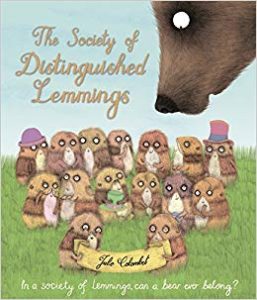The Society of Distinguished Lemmings
Author: Julie Colombet
Illustrator: Julie Colombet
Peachtree
1 March 2020
40 pages
This month’s PB review is by Ryan G. Van Cleave (lead lemming researcher at Only Picture Books) and Ringling College of Art and Design Illustration Professor (and new OPB friend) Rebecca Zomchek.
–Ryan’s Review of the Writing–
Is there ever a happy ending for a story about lemmings? Thanks to Julie Colombet’s The Society of Distinguished Lemmings, the answer is now an emphatic “yes!”
This fancy society of lemmings have 10 rules to follow, with #1 being “Lemmings Only” and #10 insisting “No Questioning the Rules.” Not a problem for these rule-following lemmings! But then lemming Bertie decides to leave the underground burrow because even distinguished lemmings can sometimes get TOO noisy. Once Bertie reaches the surface, though–gets the shock of his small life. He encounters a creature that he suspects is a bear! But Bear isn’t going to eat him–instead, it licks him, and just like that, they’re pals.
Bear doesn’t show interest in any of Bertie’s distinguished activities (painting and playing chess), but Bertie is quite taken by Bear’s most un-distinguished activities (rolling in flowers, climbing tress, and jumping in mud puddles). When the other lemmings eventually learn of Bear, they are reluctant to let him join their society despite Bertie’s hope that they do so–Bear’s a bear after all, and he doesn’t appreciate the same things that the oh-so-fancy lemmings do. “The bear will never be distinguished,” they ultimately decide.
Bertie and Bear are then left behind when the others go on a sudden vacation (the dangerous migration we all worried would come when we heard the term “lemming” via the title). Some extremely fortuitous reading material (a book called A Short History of Lemmings) concerns Bertie and Bear enough such that they rush to the ocean to ensure their lemming buddies are safe. To no one’s surprise, the lemmings aren’t safe–they swam out too far into the deep water and are exhausted. But the distance is easily covered by Bear’s superior swimming ability, and he rescues them all, which earns him immediate entry into the new Society of Distinguished Lemmings…and Bears.
I’ll let Rebecca point out the visual jokes and discuss how the comic-style multi-vocal technique works to give voice to the many, many lemmings in this story. Instead, I’ll focus on three aspects on the story side of things.
- The wordplay here is fun, with such bear-adjacent lines as “This is unbearable” and how Bear worries that things are “about to get grizzly.”
- The story offers a palatable take on kid topics such as following rules, supporting your friends, and accepting differences in others.
- Many of the funniest lines in the story appear in word balloons–kids will likely enjoy reading them, and will note different/new things with subsequent reads, much like in a well-done Search-and-Find where there’s always seemingly more to appreciate.
In sum, The Society of Distinguished Lemmings is a promising premise that ends up somewhat underdeveloped thanks to convenient moments (the right passage of the right book being read at the right time), a huh? moment (why does lemming Bertie need a book to teach him about a lemming’s penchant for a watery end via a migration?), and a relatively predictable conclusion (strong-but-shunned bear saves stodgy/snobby lemmings). Yet make no mistake–the fundamental concept is fun, the lemming art entertaining, and the sense of play welcome. Taken together, it’s a mostly encouraging debut from French author/illustrator Julie Colombet.
3.75 out of 5 pencils
– Rebecca’s Review of the Illustrations–
From the expressive and character-filled endpapers to the illustrated pages sprawling with dozens of ludicrous lemmings, The Society of Distinguished Lemmings is a fun and detail-filled adventure from beginning to end.
Colombet’s soft style, with contrasting bright-eyed characters and funny expressions, builds a wonderful bridge between comic and book form illustrations. Her detailed page layouts use speech bubbles to invite the viewer to explore her complex scenes that add to the larger story. Filled with tiny props and dozens of unique characters, these add amusing jokes and side narratives to serious situations and a larger moral.
Despite Colombet’s soft and friendly style, the images are actually quite nuanced. When we’re first introduced to our lemming protagonist, Bertie, we are shown that he is unique among his compatriots, both because of his open-minded attitude and his polka-dotted coat, instead of a traditional striped pattern. This pattern mixing is a nice visual cue of individuality for a younger audience where the other lemmings can blend together, indicating their crowd-like mentality. In each scene, as we see more of the lemmings and their new friend, Bear, the clear and exaggerated expressions really help communicate the attitudes and emotions of the characters and how they relate to each other as the story progresses. The bear’s expressions, in particular, show a great inner arc that transitions from fear to joy as his friends are rescued, resulting in a happy ending.
Some of my favorite pages are the underground scenes showing the lemmings’ home and the final scene where we see the lemmings and Bear finally relaxing together. I love the way we see dozens of characters on a page, but if we take the time, we can break down each area into unique instances and dramas so each page becomes dozens of moments the audience can come back to again and again. These scenes–filled with tiny chandeliers, dining tables with minuscule cutlery and goblets, concert halls, and portrait galleries–help contrast strongly with outdoor scenes in which we see Bertie and Bear bonding over simpler pleasures. It’s a nice visual resolution to see these two worlds merge at the end of the book in a large outdoor picnic
There are a lot of exciting details for readers young and old to discover on each page of this book. Colombet’s style brings the simple story to life and adds wonderful expression and humor to a profound narrative about learning to stand up to peer pressure, having fun, and being yourself.
4.5 out of 5 crayons
 Rebecca Zomchek is a children’s book illustrator who has worked as a concept artist and cartoonist. She earned her BFA from Syracuse University and her MFA from The School of Visual Arts; she teaches Illustration at the Ringling College of Art and Design. Rebecca likes distinguished things like classical music and museums, but also loves being outside and getting paint everywhere.
Rebecca Zomchek is a children’s book illustrator who has worked as a concept artist and cartoonist. She earned her BFA from Syracuse University and her MFA from The School of Visual Arts; she teaches Illustration at the Ringling College of Art and Design. Rebecca likes distinguished things like classical music and museums, but also loves being outside and getting paint everywhere.

